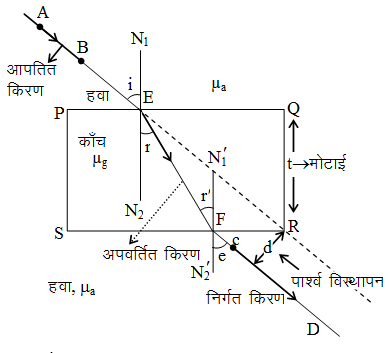Chapter : 4. Light Refraction
Refraction Through Glass Slab
Refraction Through Glass Slab
(a) Refraction through a rectangular glass slab and principle of reversibility of light :
Consider a rectangular glass slab, as shown in figure. A ray AE is incident on the face PQ at an angle of incidence i. On entering the glass slab, it bends towards normal and travels along EF at an angle of refraction r. The refracted ray EF is incident on face SR at an angle of incidence r'. The emerged ray FD bends away from the normal at an angle of refraction e.
Thus the emergent ray FD is parallel to the incident rays AE, but it has been laterally displaced with respect to the incident ray. There is shift in the path of light on emerging from a refracting medium with parallel faces.
Lateral shift :
Lateral shift is the perpendicular distance between the incident and emergent rays when light is incident obliquely on a refracting slab with parallel faces.
Factors on which lateral shift depends are :
(i) Lateral shift is directly proportional to the thickness of glass slab.
(ii) Lateral shift is directly proportional to the incident angle.
(iii) Lateral shift is directly proportional to the refractive index of glass slab.
(iv) Lateral shift is inversely proportional to the wavelength of incident light.

Proof for i = e
Case-I :
For light going from air to glass at point E.
µa sin i = µg sin r
..... (1)
Case-II :
For light going from glass to air at point F.
µg sin r = µa sin e
.....(2)
From (1) & (2) we can say that i = e
→ incident & emergent rays are parallel to each other.
(a) Refraction through a rectangular glass slab and principle of reversibility of light :
Consider a rectangular glass slab, as shown in figure. A ray AE is incident on the face PQ at an angle of incidence i. On entering the glass slab, it bends towards normal and travels along EF at an angle of refraction r. The refracted ray EF is incident on face SR at an angle of incidence r'. The emerged ray FD bends away from the normal at an angle of refraction e.
Thus the emergent ray FD is parallel to the incident rays AE, but it has been laterally displaced with respect to the incident ray. There is shift in the path of light on emerging from a refracting medium with parallel faces.
Lateral shift :
Lateral shift is the perpendicular distance between the incident and emergent rays when light is incident obliquely on a refracting slab with parallel faces.
Factors on which lateral shift depends are :
(i) Lateral shift is directly proportional to the thickness of glass slab.
(ii) Lateral shift is directly proportional to the incident angle.
(iii) Lateral shift is directly proportional to the refractive index of glass slab.
(iv) Lateral shift is inversely proportional to the wavelength of incident light.

Proof for i = e
Case-I :
For light going from air to glass at point E.
µa sin i = µg sin r
..... (1)
Case-II :
For light going from glass to air at point F.
µg sin r = µa sin e
.....(2)
From (1) & (2) we can say that i = e
→ incident & emergent rays are parallel to each other.
Trending Articles & Blogs
- Physics Tutor, Math Tutor Improve Your Child’s Knowledge
- How to Get Maximum Marks in Examination Preparation Strategy by Dr. Mukesh Shrimali
- 5 Important Tips To Personal Development Apply In Your Daily Life
- Breaking the Barriers Between High School and Higher Education
- 14 Vocational courses after class 12th
- Tips to Get Maximum Marks in Physics Examination
- Get Full Marks in Biology Class 12 CBSE
Download Old Sample Papers For Class X & XII
Download Practical Solutions of Chemistry and Physics for Class 12 with Solutions
Recent Questions Asked
- Newton’s laws of motion asked by Dr. Mukesh Shrimali
- Process of nutrition in Amoeba asked by Rajiv Sharma
- Importance of studying physics subject in school after 10th asked by Rajiv
- Refraction Through Prism in Different Medium asked by Kirti Sharma
- Ratio and Proportion Question asked by Education Desk
- Explain all the 12 tenses with example asked by Qwerty
- Refraction Through Prism in Different Medium asked by Seema Shrimali